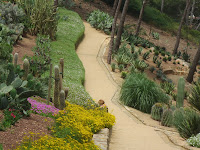When we left Bilbao May 30, my feelings were bittersweet. We knew that we would miss the former, but took delight in abandoning the climate. Ellen was thinking of the delights of swimming in the warm Mediterranean and the rumors of pristine national parks we'd explore along the way as we packed, cleaned and said our goodbyes to people and places our hearts had become attached to. Tom loaded the packing crates...no, they just seemed as heavy as packing crates, they were still suitcases...in the rental car and we were off to our first stop, Hondarribia (B on the map).
Hondarribia is where Spain stops and France begins. It's a ancient walled city on the banks of the river Bidasoa which serves both as the border and an excellent natural harbor. It's fun to prowl around the top of the walls and imagine that it's the year 1638 and you are guarding the city from Louis XIII's French troops. When night descends you are delighted it's 2013 and you can take refuge in one of the excellent restaurants and enjoy pintxos and wine, rather than heading to a drafty hall with warm ale and a smokey fire. (stock photos!)

The next day we were up and on the road early. We were headed to the Valle de Baztán (C) for a walk in the Señorío de Bértiz, a XIVth century holding with an extensive forest of beech (las hayas), oaks (los robles), chestnuts (las castañas), hazelnuts (las avellanas) and alder (los alisos). This is also the home of the Lamia, a mermaid-like creature that inhabits the waters of the river Bidasoa. They are said to have perished around the same time Christian hermitages were built on the banks of their beloved river; some say they were poisoned and others say they died of grief. They are still beloved by all and appear on many local heraldic devices.
The Basques are firmly in line with the "all men are created equal" doctrine and as a result, almost every family has their own heraldic device, proudly displayed on their home. No need to have one bestowed by some ridiculous foreign king; figure out what suits your family and go for it!
The day was not cooperative either weather-wise or Lamia-viewing wise, but we enjoyed the beautiful deciduous trees, newly in leaf, and the riot of green-all tints and hues. The paths were wide, well marked, and peacefully, rather than dramatically, beautiful. El Señorío de Bértiz lacked the rugged, wild beauty of a Yosemite or a Yellowstone; it was more like an enormous, well-kept city park.
Because the valleys of the border mountains, including the Pyrenees, run more or less in a north/south direction with few connecting roads between the valleys, we actually had to travel into France to get to our next destination in the Valle de Salazar. On our way to Cambo les Bains (E) for the night, we stopped in the French town of Espelette (D). Espelette, as any true gourmet will tell you, is a unique little spot due to the peppers they grow. The peppers are actually protected under a D.O.M. You can't call a pepper Espelette unless it's grown in the area around the town, even if you use seeds from an Espelette pepper. Is this brilliant marketing or pure hype?
Cute, isn't it?
The architecture is so different from Spain and the food was fantastique. Here's a link to a recipe for piperade, a magical amalgamation of peppers that shows you how to substitute cayenne for espelette peppers:
http://www.chow.com/recipes/10987-piperade
Ellen has some ground espelette pepper she'll gift to the first Blog reader that requests it!
Cambo les Bains itself was a bit strange. Once a well known treatment center for respiratory diseases, it has retained a focus on rehabilitation by offering lots of clinics and spas for unspecified conditions. Ellen thinks she might sign up the next time she get the vapors. Evidently people need lots of peace and quiet and good food to recover their health and that's what they find in Cambo. The parade seemed to be the biggest event except for the cherry festival in the next town. And, before you ask, we have no idea what the axes represent!
We drove down the Roncesvalles (F) valley through fog and drizzle so thick we strained to avoid a collision with numerous pilgrims just starting their trek on the Camino de Santiago de Compostela. We passed the albergue where Tom had started his trip more than 2 months previously. At least there was no snow this time!
 |
| March 16, 2013 |
We liked Ochagavia, too. It's an unprepossessing town somewhat focused on mountain sports, with the grey local stone used for buildings, roads and plazas and a small, rocky river, very clear, flowing through the middle of town. One might think that the colors would be monotonous, but they were actually very harmonious and peaceful.
It was just outside of Ochagavia we got our first views of the Pyrenees. Make sure you enlarge these to get a better sense of the scope and majesty of the mountains.
By now, we were excited that our next stop, Torla (H) was actually in the Pyrenees, in the Parque Nacional de Ordesa y Monte Perdido aka Ordesa National Park. Although we would be leaving the Basque Country and entering Cataluña, we were ready to move on and enjoy the high mountains. Ellen wondered: would we actually see snow close up?For the answer to that and other serious questions, see part 2 of this blog!



























































